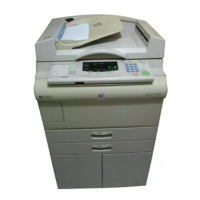If there is residual voltage on the drum, this area of the drum will attract
some toner, making a V
R
pattern. The ID sensor checks the reflectivity of the
V
R
pattern. This sensor output voltage is V
RP
.
In V
R
detection, V
RP
is compared with V
RG
.
• V
RG
is the reflectivity of the bare area of the drum, measured by the ID
sensor. It has the same value as V
SG
(see Image Density Control - V
SG
and V
SP
Detection).
• V
RP
is the output from the ID sensor reflected from the V
R
pattern.
When the drum residual voltage increases, the V
R
pattern becomes darker.
Then, V
RP
decreases and the V
RP
/V
RG
ratio decreases.
Then the CPU increases the negative development bias voltage to prevent
dirty background, and simultaneously increases the negative drum charge
roller bias voltage to prevent low image density. This is the V
R
correction.
Table 11. V
R
correction
ID Correction Drum Charge Roller
Correction Voltage
Development Bias
Correction Voltage
±0 V
–40 V –80 V
V
RP
/V
RG
x 100(%)
64 ~ 100 60 ~ 100 54 ~ 100
±
0 V
±
0 V
47 ~ 63 42 ~ 59 36 ~ 53 –40 V –40 V
35 ~ 46 30 ~ 41 24 ~ 35 –80 V –80 V
26 ~ 34 21 ~ 29 16 ~ 23 –120 V –120 V
0 ~ 25 0 ~ 20 0 ~ 15 –160 V –160 V
For example, taking the ID correction to be zero for now, if V
RP
/V
RG
is 45%,
the drum charge and development bias corrections will both be -80V.
V
R
correction also depends on the current V
SP
pattern ID correction that is
being used. If development bias has been increased by ID correction, the V
R
correction may be smaller in some cases to take this into account. This is
shown by both the table above and the following figure.
ID correction
0 V
–40 V
–80 V
Detailed
Descriptions
STM 2-19 A156/A160/A162

